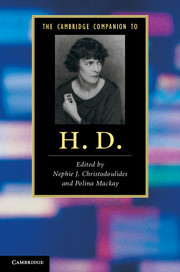Book contents
- Frontmatter
- Introduction
- PART I CONTEXTS AND ISSUES
- 1 ‘Uncanonically seated’: H.D. and literary canons
- 2 Facts and fictions
- 3 H.D. and the ‘little magazines’
- 4 H.D.'s modernism
- 5 H.D. and gender: queering the reading
- 6 Reading H.D.: influence and legacy
- PART II WORKS
- Further reading
- Index
- Cambridge Companions to…
6 - Reading H.D.: influence and legacy
from PART I - CONTEXTS AND ISSUES
Published online by Cambridge University Press: 28 November 2011
- Frontmatter
- Introduction
- PART I CONTEXTS AND ISSUES
- 1 ‘Uncanonically seated’: H.D. and literary canons
- 2 Facts and fictions
- 3 H.D. and the ‘little magazines’
- 4 H.D.'s modernism
- 5 H.D. and gender: queering the reading
- 6 Reading H.D.: influence and legacy
- PART II WORKS
- Further reading
- Index
- Cambridge Companions to…
Summary
‘Hermione lived her life and lives in history.’ So murmurs the speaker of H.D.'s long, reflective sequence ‘Winter Love’. This melancholy note provides an apt starting point for a study of H.D.'s legacy for a number of related reasons.
First, the publication history of this particular poem evidences one of the obstacles to establishing definitive lines of influence in H.D.'s case. Written in 1959 and conceived, as Norman Pearsall reports, as the ‘coda’ to 1961's Helen in Egypt, ‘Winter Love’ was not finally published until 1972 (H.D., Hermetic, p. viii). This sizeable – although not in H.D.'s oeuvre unusual – delay means that what may appear at first to be striking similarities (for instance, between the structure, voice and imagery of this poem and examples from Sylvia Plath's work) should be dismissed on the grounds that Plath predeceased the publication of ‘Winter Love’, or argued on rather different premises. In like manner, H.D.'s Asphodel, written in the early 1920s, remained unpublished until 1992. Although editor Robert Spoo identifies in it a ‘high modernis[t]’ tendency ‘toward strong formal control and experimental abandon’, its attenuated publication history makes it problematic to argue for its explicit influence on the wider development of a modernist aesthetic.
The second reason for taking ‘Winter Love’ as a point of departure lies in the speaker's recognition that one might live two different lives simultaneously or palimpsestically, to use one of H.D.'s favoured figures.
- Type
- Chapter
- Information
- The Cambridge Companion to H. D. , pp. 77 - 92Publisher: Cambridge University PressPrint publication year: 2011



